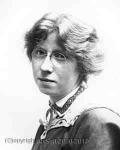Imogen Cunningham
Imogen Cunningham
Mjesto: Portland
Rođen: 1883
Smrt: 1976
Biografija:
Imogen Cunningham was an American photographer known for her botanical photography, nudes, and industrial landscapes. Cunningham was a member of the California-based Group f/64, known for its dedication to the sharp-focus rendition of simple subjects.
Cunningham was born in Portland, Oregon to father Isaac Burns Cunningham and mother Susan Elizabeth Cunningham (née Johnson). Her parents were from Missouri, though both of their families originally came from Virginia. Cunningham was the fifth of 10 children.
She grew up in Seattle, Washington and attended the Denny School at 5th and Battery Streets in Seattle.
In 1901, at the age of eighteen, Cunningham bought her first camera, a 4x5 inch view camera, via mail order from the American School of Art in Scranton, Pennsylvania.
She entered the University of Washington where she became a charter member of the Washington Alpha Chapter of Pi Beta Phi Fraternity for Women. It was not until 1906, while studying at the University of Washington in Seattle, that she was inspired to take up photography again by an encounter with the work of Gertrude Käsebier. With the help of her chemistry professor, Horace Byers, she began to study the chemistry behind photography and she subsidized her tuition by photographing plants for the botany department.
In 1907, Cunningham graduated from University of Washington with a degree in chemistry. Her thesis was titled "Modern Processes of Photography." While there, she served as class vice-president, participated in the German Club and Chemistry Club, and was on the yearbook staff.
After graduating from college in 1907, Cunningham went to work for Edward S. Curtis in his Seattle studio, gaining knowledge about the portrait business and practical photography. Cunningham worked for Edward S. Curtis on his project of documenting American Indian tribes for the book The North American Indian, which was published in twenty volumes between 1907 and 1930. Cunningham learned the technique of platinum printing under Curtis’s supervision and became fascinated by the process.
In 1909, Cunningham was awarded the Pi Beta Phi Graduate Fellowship. This grant allowed her to work at the Technische Hochschule in Dresden, where she helped the photographic chemistry department find cheaper solutions for the expensive and rare (due to World War I) platinum used for printing. Using this fellowship, Cunningham traveled to Germany to study with Professor Robert Luther at the Technische Hochschule in Dresden, Germany. In Dresden she concentrated on her studies and didn't take many photographs. In May 1910, she finished her paper, "About the Direct Development of Platinum Paper for Brown Tones", describing her process to increase printing speed, improve clarity of highlights tones, and produce sepia tones.
On her way back to Seattle, she met with photographers Alvin Langdon Coburn (in London) and Alfred Stieglitz and Gertrude Käsebier in New York.
In Seattle, Cunningham opened a studio and won acclaim for portraiture and pictorial work. Most of her studio work of this time consisted of sitters in their own homes, in her living room, or in the woods surrounding Cunningham's cottage. She became a sought-after photographer and exhibited at the Brooklyn Institute of Arts and Sciences in 1913.
In 1914, Cunningham's portraits were shown at An International Exhibition of Pictorial Photography in New York. Wilson's Photographic Magazine published a portfolio of her work.
The next year, she married Roi Partridge, a teacher and artist. He posed for a series of nude photographs, which were shown by the Seattle Fine Arts Society. Although critically praised, Cunningham didn't revisit those photographs for another fifty-five years. Between 1915 and 1920, Cunningham continued her work and had three children (Gryffyd, Rondal, who also became a photographer, and Padraic) with Partridge.
In 1920, the family moved to San Francisco, where Partridge taught at Mills College.
Cunningham refined her style, taking a greater interest in pattern and detail and becoming increasingly interested in botanical photography, especially flowers. Between 1923 and 1925 she carried out an in-depth study of the Magnolia flower. Later in the decade she turned her attention toward industry, creating several series of industrial landscapes in Los Angeles and Oakland.
In 1929, Edward Weston nominated 10 of Cunningham's photographs (8 botanical, 1 industrial, and 1 nude) for inclusion in the "Film und Foto" exhibition. Her renowned Two Callas debuted in that exhibition.
Cunningham once again changed direction, becoming more interested in the human form, particularly hands, and she was fascinated with the hands of artists and musicians. This interest led to her employment by Vanity Fair, photographing stars without make-up.
As Cunningham moved away from pictorialism to embrace sharp-focus photography she joined with like-minded photographers to form Group f/64 to promote this style of photography, and took part in their 1932 exhibition.
More...
Wikipedia link: Click Here














